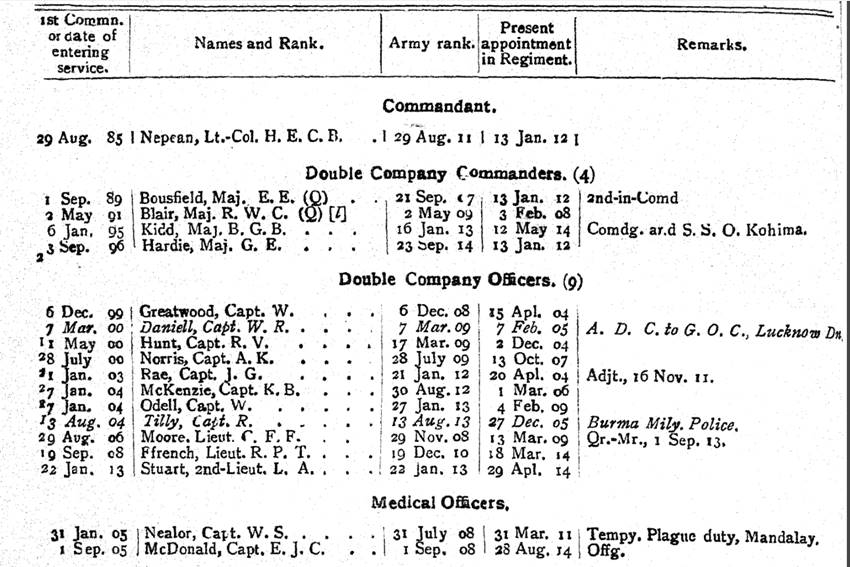This article looks at the 123rd Outram’s Rifles, an Indian infantry regiment and will help you research those who served with it during the First World War. I have written a separate article about the short-lived 2nd Battalion 123rd Outram’s Rifles and a series of guides to help you research soldiers who served in the Indian Army during the war. To view the guides click on the link below:
The 123rd Outram’s Rifles in the First World War
Lineage: ”Raised, in 1820, to a considerable extent from men who had served at the battle of Kirkee in the disbanded Dapuri Battalion (Peishwa’s service) under Major Ford, Madras Army, and was originally designated the 1st Battalion, 12th Regiment of Bombay Native Infantry”. Indian Army List, October 1914. Then the 23rd Regiment of Bombay Native Infantry in 1824, the 23rd Regiment of Bombay Native (Light) Infantry in 1841, the 23rd Regiment of Bombay (Light) Infantry in 1885, then unauthorisedly designated the 2nd Battalion, Bombay Rifle Regiment in 1889 its title was corrected to the 23rd Regiment (2nd Battalion, Rifle Regiment) of Bombay Infantry in 1889. Then the 23rd Bombay Rifles in 1901, the 123rd Outram’s Rifles in 1903 and the 4th Battalion Rajputana Rifles in 1922.
Composition of the Regiment in 1914: 4 Companies of Rajputana Jats, 2 Companies of Rajputana Rajputs and 2 Companies of Punjabi Musalmans. 1919: 2 Companies of Rajputana Jats, 1 Company of Rajputana Rajputs and 1 Company of Punjabi Musalmans.
Location in July 1914: The 123rd Outram’s Rifles was stationed at Manipur (India) having arrived from Bhamo, Burma (Kachin, Myanmar) on 23rd December 1913.
The 123rd Outram’s Rifles was stationed at Manipur (now a state in the northeast of present-day India, close to Burma) in August 1914. The Regiment had been inspected earlier in the year by Lieutenant-Colonel C. W. Somerset, 48th Pioneers who reported:
Turn-out: Very satisfactory.
Efficiency in drill: Very satisfactory.
Equipment: Complete and serviceable.
Personnel: The British officer are active intelligent and very keen. The Indian officers are a fine lot of men, and know their work. The rank and file are very fit and active.
Physique: Satisfactory.
Recruits: Satisfactory. Of prescribed classes.
General efficiency: All officers, British and India, were tested in the practical handling of their men with satisfactory results. The individuality and independence of action of all ranks is properly encouraged. The regimental system is directed to maintain the men in health, comfort and efficiency. The war training is thorough. A well commanded regiment-efficient.
Fitness for active service: Fit for service.
Confidential review reports on Indian Army units for 1913-1914: IOR/L/MIL/7/17023.
While the 123rd Outram’s Rifles remained in India for the first two years of the war, it did provide drafts to other regiments including the 24th Punjabis and 125th Napier’s Rifles. Captain Kenneth Buchanan McKenzie was one of the officers who served with another regiment being attached to the 58th Vaughan’s Rifles in France. In his confidential report for 1913-14, his commanding officer described McKenzie as:
Entirely reliable, energetic and capable officer. Has not passed Musketry. Recommended for promotion in due course. Has not passed for promotion. Rides and speaks Hindustani well. On the staff college list.
Captain Mckenzie was initially posted as missing believed killed on the opening day of the Battle of Loos on 25 September 1915. McKenzie was later confirmed killed and is commemorated on the Neuve Chapelle Memorial to the missing.
While the Regiment served in India it raised a second battalion at Baroda (Gujarat, India) on 29 December 1915 and I have written a separate article about this battalion here: 2nd Battalion 123rd Outram’s Rifles. The extract below was taken from the October 1914 Indian Army List which recorded British officers serving with the Regiment.
In the summer of 1917, the 123rd Outram’s Rifles joined the 234th Infantry Brigade, 75th Indian Division and there is another war diary covering the period between June 1917 and May 1919. The Regiment would take part in the Battle of Megiddo (19 – 25 September 1918) and sustained between 60 and 70 casualties on the opening day of the battle. In June 1919, the 123rd Outram’s Rifles joined the 31st Infantry Brigade, 10th Indian Division. There is a final war diary covering the period between June 1919 and March 1920 when the Regiment was at Heliopolis, near Cairo (now a suburb of the city). The 123rd Outram’s Rifles remained in Egypt until either late 1920 or early 1921 before returning to India. In the July 1921 Indian Army List, the 123rd Outram’s Rifles was stationed at Mhow (Madhya Pradesh, India) with a detachment at Pachmarhi (Madhya Pradesh, India). In 1922, the 123rd Outram’s Rifles became the 4th Battalion Rajputana Rifles.
War Diaries of the 123rd Outram’s Rifles
There are three war diaries for the 123rd Outram’s Rifles and as of January 2017, none have been digitized and they can only be viewed at the National Archives. I have copies of all the war diaries and have transcribed some of the entries below.
- Date: 11 November 1916 – 31 May 1917
- 29th Indian Infantry Brigade, Suez Canal Defences
- Reference: WO 95/4436
- Notes: A good detailed war diary especially concerning the mobilization of the Regiment. There was an outbreak of plague in April 1917, and two appendices cover this episode. One was written by the commanding officer concerns Major Daniell and the other written by Daniell on the state of Gurkha Post. There are also two appendices showing the distribution of the Regiment in January and February 1917.
- Date: 01 June 1917 – 31 May 1919
- 234th Infantry Brigade, 75th Indian Division, Egyptian Expeditionary Force
- Reference: WO 95/4694
- Notes: A very good war diary not only due to its daily entries but also due to a large number of appendices it contains. These include orders, and a list of casualties sustained during April 1918, and lists of drafts. There are at least 300+ Indian soldiers listed in this war diary with regimental number and company.
- Date: 01 June 1919 – 31 March 1920
- 31st Infantry Brigade, 10th Indian Division, Egyptian Expeditionary Force
- Reference: WO 95/4586
- Notes: A short typed war diary where each month is written on a single page. British and Indian officers appear throughout.
Further Sources for the 123rd Outram’s Rifles
For information regarding British and Indian officers who served with the 123rd Outram’s Rifles, the Indian Army List should be consulted. A good source of information for the Regiment and in particular the British officers who served with it is the 123rd Outram’s Rifles’ confidential reports held at the British Library: Confidential Reports on Regiments etc. These reports also contain the annual reports of the British officers serving with it. Though when the 123rd Outram’s Rifles was abroad only its Depot and the British officers serving with it are reported on.
There is also a regimental history I can recommend: Outram’s Rifles: A History of the 4th Battalion 6th Rajputana Rifles by H. G. Rawlinson.
Extracts from War Diaries of the 123rd Outram’s Rifles
11 November 1916 – 31 May 1917, Suez Canal Defences, WO 95/4436
13 November 1916 – Multan – Leave and furlough men recalled by wire, Field Service equipment surveyed, following wanted 2 tripods for machine guns, one mule, mekometers under repair at Arsenal, hobnails being put on boots, blanket stretchers complete, bayonets being sharpened, equipment being dubbined.
14 November 1916 – 14 days required to complete mobilization owing to recruiters and leave men being recalled from Poonch and Rajputana.
13 January 1917 – Multan – Orders received to mobilize for Force E as ordered originally. Battalion will take machine guns but no mules or other transport animals. Band to accompany. Telegraph when ready to move.
28 January 1917 – Arrived Suez and disembarked on arrival and proceeded to camp by train.
20 March 1917 – Information received that Indian Regiments in Egypt are to be raised to 1000 including 10% reinforcement and if recruiting is good to 1000 excluding reinforcement.
08 March 1917 – Orders received for all ranks to be vaccinated except those who show a good scar and were done in last 7 years.
01 June 1919 – 31 March 1920, Egyptian Expeditionary Force, WO 95/4586
23 October 1919 – Heliopolis – Hindu Holiday “Diwali” British Officers entertained in evening by Indian Officers.
31 October 1919 – Heliopolis – Orders received for revolvers to be worn by all officers travelling by rail and when off main thoroughfares. Men on pass in Cairo warned not to [missing word, possibly interfere] with “demonstrations” or to seize flags or to take any independent action which would bring them into collision with such demonstrations.
20 October 1919 – Heliopolis -Football League match v 22nd Manchesters. Result: Manchester 3. Regiment 2.
21 October 1919 -Heliopolis – Men ordered to wear entrenching tool helves when walking out.
22 October 1919 – Heliopolis -Football League match v 11 Scottish Rifles at Tanta. Result S.R. 11. Regiment 0 [ The 123rd Outram’s Rifles won the Egyptian Expeditionary Force Hockey League].
01 March 1920 – Heliopolis – All ranks subscriptions to the Jamat Funds revived, for the first time since the war.

